Hiroshima, the wounded limb of Japan, carries a profound narrative of pain and suffering. This city, forever marked by tragedy, stands as a testament to strength and hope.
It reminds the world of the scars left by war and the continuing spirit of those who survived to rebuild their lives. And that’s the reason it is one of the best places to visit in Japan.
As you already know, Hiroshima is famous for its painful history, peaceful memorials, and scenic beauty.
Now, if you think about what you should see in Hiroshima, the top attractions include the Hiroshima Peace Memorial Park and Museum, the iconic Atomic Bomb Dome (Genbaku Dome), and the beautiful Itsukushima Shrine on Miyajima Island, famous for its floating torii gate. Tourists also enjoy exploring Hiroshima Castle, walking through Shukkeien Garden, and tasting the city’s signature dish, Hiroshima-style okonomiyaki.
There are numerous beautiful places to visit in Hiroshima, but you should prepare yourself emotionally to engage with its deep history, which is an essential part of the city’s identity.
So, let’s explore the top 10 places to visit in Hiroshima.
Quick Facts about Hiroshima
| Location | Chūgoku region, western Honshu, Japan |
| Famous For | Peace Memorial Park, Atomic Bomb Dome, Itsukushima Shrine |
| UNESCO Sites | Atomic Bomb Dome (1996), Itsukushima Shrine (1996) |
| Best Time to Visit | March-May (spring) & October-November (autumn) |
| Local Dish | Hiroshima-style okonomiyaki (savoury pancake) |
| Nearest Airport | Hiroshima Airport (HIJ)- 50 km east of the city |
| Day Trips | Miyajima Island, Iwakuni Kintai Bridge, Onomichi |
Tragic History of Hiroshima
As we all know, during World War II, Hiroshima was bombed by the United States on August 6, 1945. There were many reasons- The U.S. wanted to end the war quickly by using atomic bombs to force Japan to surrender without conditions. This plan aimed to avoid a long and costly invasion of Japan and to reduce potential American casualties.
Did you know why Hiroshima was chosen for bombing?
It was chosen as a target because it was a key military centre and had mostly avoided the extensive firebombing that destroyed many other Japanese cities, according to the Atomic Archive.
The decision aimed to show the bomb’s destructive power and discourage the Soviet Union after the war. The bombing demonstrated the weapon’s strength and influenced the balance of power in the post-war world, especially concerning the Soviet Union and Hiroshima.
The initial death toll due to the bombing was 70,000 instant deaths due to the blast, heat, and radiation. Later, it was believed to rise between 90,000 and 166,000. Many others suffered from long-term effects of radiation exposure, like cancer and other health problems. This may have led to a higher overall death toll in the years after the bombing.
Best Places to Visit in Hiroshima
Hiroshima is a remarkable city known for its rich history, welcoming people, and poignant ruins. It stands tall to narrate to tourists its suffering endured during past events and call for peace. Let’s take a quick glance at the list of the best places to visit in Hiroshima.
Hiroshima Tourist Attractions:
|
Hiroshima Peace Memorial Park and Museum
Hiroshima Peace Memorial Park is the heart of the city’s remembrance. Built on the open field left after the atomic bombing, it stands as a place of reflection, honouring the victims and reminding the world of the need for lasting peace.
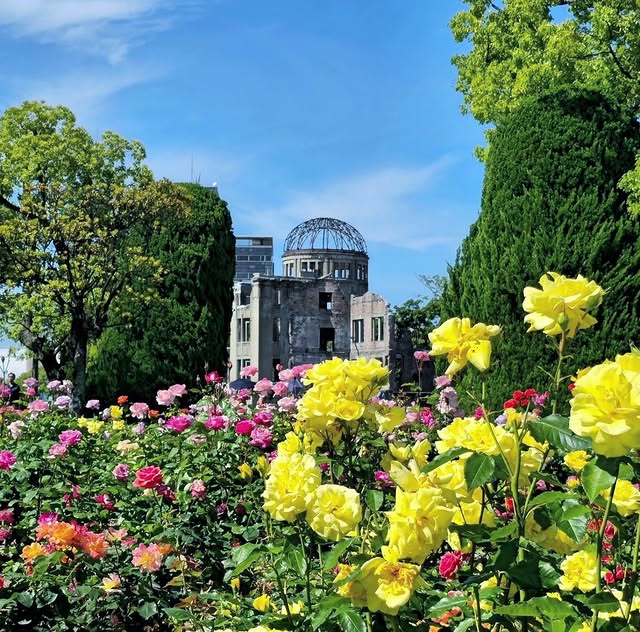
The area where the park is now located was once the busiest part of Hiroshima. After the blast in 1945, everything was flattened into silence and ruin. In the years that followed, the city decided to transform the devastation into a space of memory and hope.
The Peace Memorial Park represents a sense of solidity and a universal cry for a world without nuclear weapons. It’s not just about mourning; it’s also about inspiring future generations to embrace peace.
Within the park, visitors can explore,
- The Hiroshima Peace Memorial Museum
- The Cenotaph for the victims
- The Flame of Peace
- The Children’s Peace Monument (dedicated to Sadako Sasaki).
Each site tells a story, making the park one of the most moving places you’ll ever visit in Japan.
Atomic Bomb Dome
The Hiroshima Peace Memorial, also known as the Genbaku Dome, commemorates the scars of the bomb drop.
Before 1945, the Atomic Bomb Dome was known as the Hiroshima Prefectural Industrial Promotion Hall. It was a modern building in a European style, used for exhibitions and cultural events. The hall was a proud symbol of the city’s growth and progress.
On 6 August 1945, an atomic bomb exploded almost directly above the building. It was destroyed in seconds.
Unlike most nearby structures, its steel frame and part of its walls survived, creating a haunting skeleton against the sky. While everything else turned to ashes, the Dome remained in ruins, serving as a stark reminder of the city’s darkest day.
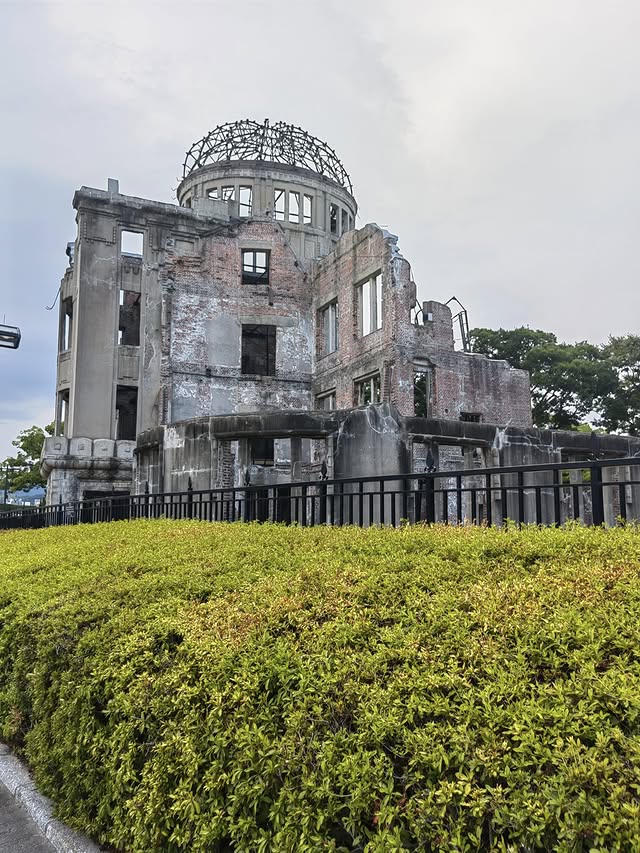
Today, the Atomic Bomb Dome is preserved exactly as it was after the explosion and recognised as a UNESCO World Heritage Site.
It symbolises both the horror of nuclear war and the resilience of Hiroshima’s people. For many visitors, it serves as a powerful call for peace- a reminder of the past and a hope for a future without nuclear weapons.
Source: Check out this video posted by UNESCO, which shows the visual representation of doomsday hitting the building.
Itsukushima Shrine
Imagine this- the sun dipping low, the water glowing golden, and the vermilion torii gate rising proudly from the sea, with quiet mountains behind. It’s the kind of view that stays in your heart rent-free after you’ve left.
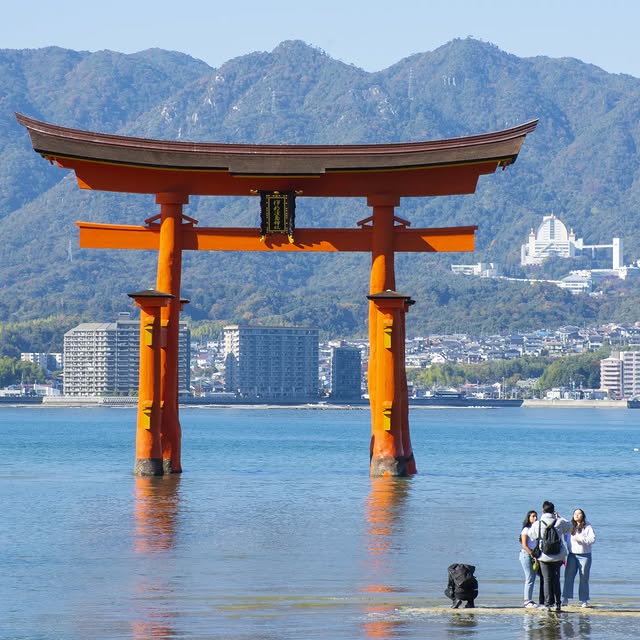
Itsukushima Shrine is one of Japan’s most loved landmarks, sitting gracefully on Miyajima Island near Hiroshima. The shrine is famous for its giant red torii gate that looks like it’s floating on the sea when the tide is high- a view that feels almost magical.
Built in the 12th century, the shrine has stood for centuries as a masterpiece of Japanese design.
In the old days, visitors would arrive by boat, passing through the torii gate before stepping onto the shrine’s wooden corridors above the water. This unique setting made it a place of wonder for tourists from all over the world.
You can wander through its elegant wooden halls, admire the torii gate at different tides, and explore the island’s peaceful streets, playful deer, and hiking trails that open up to breathtaking sea views.
Mount Misen (Miyajima)
Mount Misen is the highest peak on Miyajima Island, standing at 535 metres. It’s not just a mountain- it’s a spiritual place, home to ancient temples and legends that make the climb feel more meaningful than just a hike.
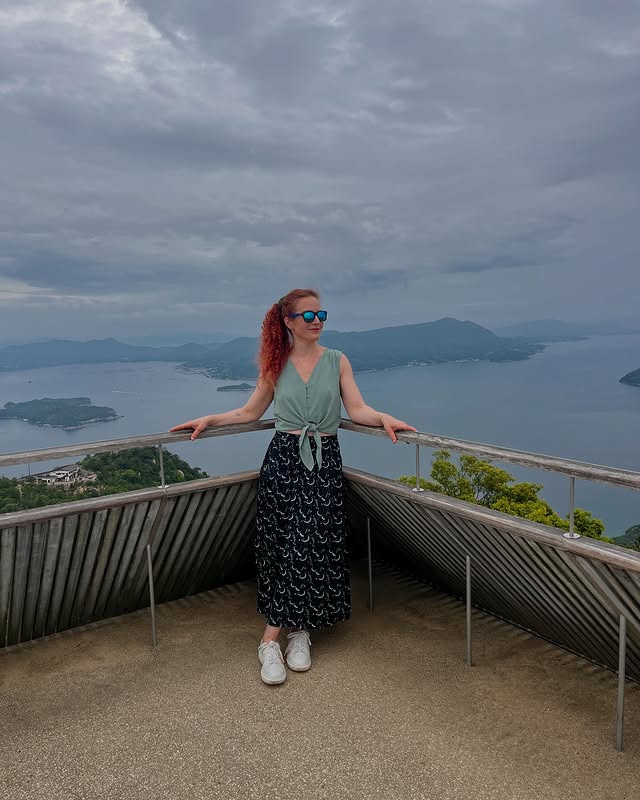
Things to Do on Mount Misen (Miyajima)
- Ride the Miyajima Ropeway
- Hike to the Summit
- Visit Reikado Hall (Hall of the Eternal Flame)
- Explore Daisho-in Temple
- Spot the Wild Monkeys
- Enjoy Panoramic Views
- Catch a Sunset
For centuries, Mount Misen has been considered sacred in Japanese Buddhism. It is said that the monk Kobo Daishi, who founded Shingon Buddhism, once trained here.
The mountain is filled with old temples, statues, and even an eternal flame that has been burning for over 1,200 years at the Reikado Hall.
Shukkei-en Garden
Shukkei-en means “shrunken scenery,” and that’s exactly what it feels like- a miniature world where mountains, rivers, and forests are recreated in perfect harmony. It is a beautiful Japanese garden right in the heart of Hiroshima.
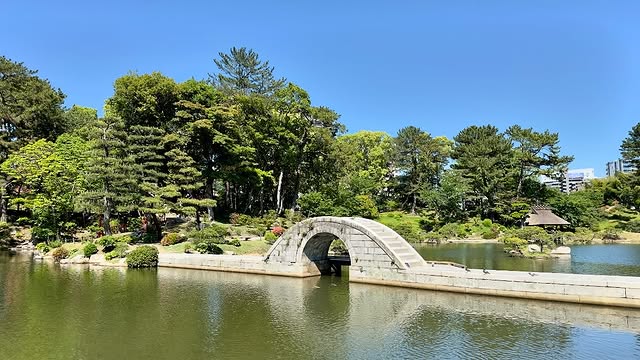
The garden was first built in 1620 for a feudal lord and has been loved by locals for centuries. Even though it was badly damaged during the atomic bombing, it was lovingly restored, and today it stands as a quiet escape from the city.
You can wander around winding paths, cross charming wooden bridges, and watch colourful koi fish in the central pond. Tea houses are dotted throughout the garden, offering a serene spot to pause. In spring, cherry blossoms light up the garden, while autumn brings fiery shades of red and gold.
Hiroshima Castle
Hiroshima Castle, also called “Carp Castle,” is a grand wooden keep rising above calm waters, framed by pink cherry blossoms in spring.
It is not just a fortress; it narrates a story of strength, survival, and quiet beauty. Originally built in the late 16th century, it was once the political and cultural heart of Hiroshima.
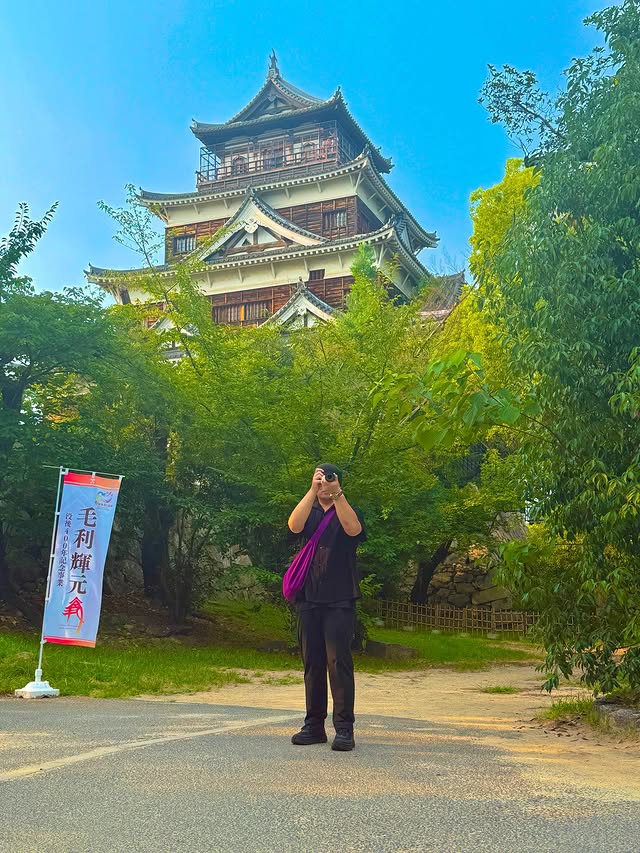
The castle was destroyed by the atomic bomb in 1945, but it was faithfully rebuilt in 1958. Today, the five-storey main keep is a museum that tells the story of Hiroshima’s history before the war. Its elegant wooden design and scenic setting make it a place where history feels alive.
Hiroshima Castle symbolises resilience. Despite being reduced to ruins, it rose again to remind the world of the city’s long legacy beyond the bombing. It’s also a proud symbol of Hiroshima’s samurai heritage.
Inside, you’ll find exhibits about,
- Samurai culture
- Castle life
- Hiroshima’s past
Go to the top floor for great views of the city and the area around it. Outside, the castle grounds are ideal for a walk, especially in spring when the cherry blossoms look lovely in the moat.
Okonomimura (Hiroshima’s Food Village)
Okonomimura symbolises Hiroshima’s spirit of comfort, warmth, and togetherness. Sharing a hotplate meal here isn’t just about food- it’s about community and joy.
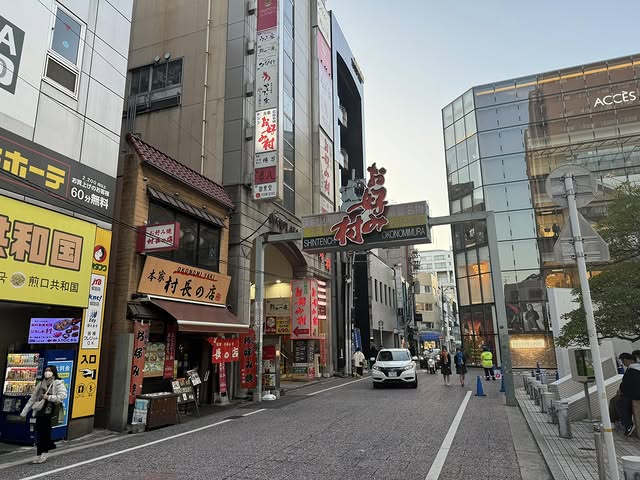
Okonomimura is a lively food theme building in downtown Hiroshima, packed with small stalls and restaurants, all serving the city’s most famous dish- Hiroshima-style okonomiyaki.
Imagine a tasty maze of flavors. Each turn offers sizzling sounds and delicious smells that make you want to eat. After World War II, okonomiyaki became a comfort food for locals- cheap, filling, and tasty.
Over the years, Hiroshima gave it its own twist by layering noodles, eggs, cabbage, and savoury sauces. Okonomimura brought together many stalls under one roof, turning it into the ultimate place to try this local favourite.
You’ll find around 20 stalls, each with its own style of okonomiyaki. Sit at the counter, watch the chefs skillfully flip giant pancakes on hot griddles, and try toppings like cheese, seafood, or extra noodles. It’s lively, cosy, and a true local experience.
Daishoin Temple (Miyajima)
Daishō-in is a beautiful Buddhist temple located at the foot of Mount Misen on Miyajima Island. It’s one of those places that feels calm the moment you step in, with stone paths, statues, and lanterns quietly guiding you through.
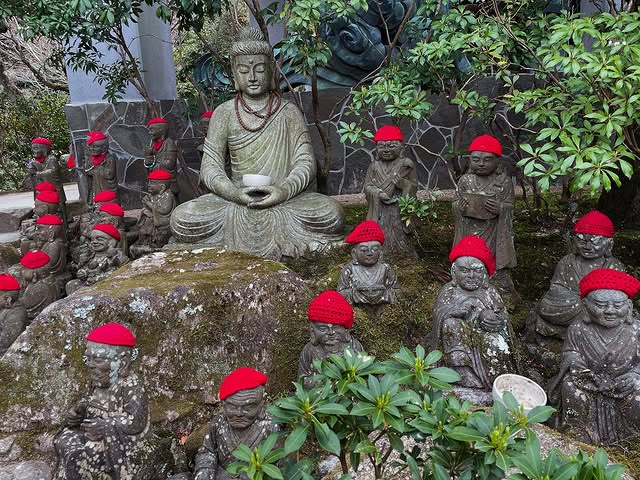
The temple was founded over 1,000 years ago by the monk Kobo Daishi, and it has been a place of prayer ever since. Walking around, you’ll notice how everything- from the mossy steps to the gentle sound of bells- feels connected to nature and time.
There are prayer wheels you can spin as you walk, colourful halls, a cave lit with hundreds of tiny lanterns, and countless statues with their own little personalities. If you visit in autumn, the fiery red maple leaves make it even more magical.
Daishō-in is about peace, reflection, and harmony. It invites you to slow down, look around, and simply enjoy the quiet beauty of the moment.
Saijo Sake Breweries
Saijō, a charming district in Higashihiroshima, is one of Japan’s most famous sake towns. With centuries-old breweries lined along narrow streets, it’s the perfect place to taste authentic Japanese sake right where it’s made.
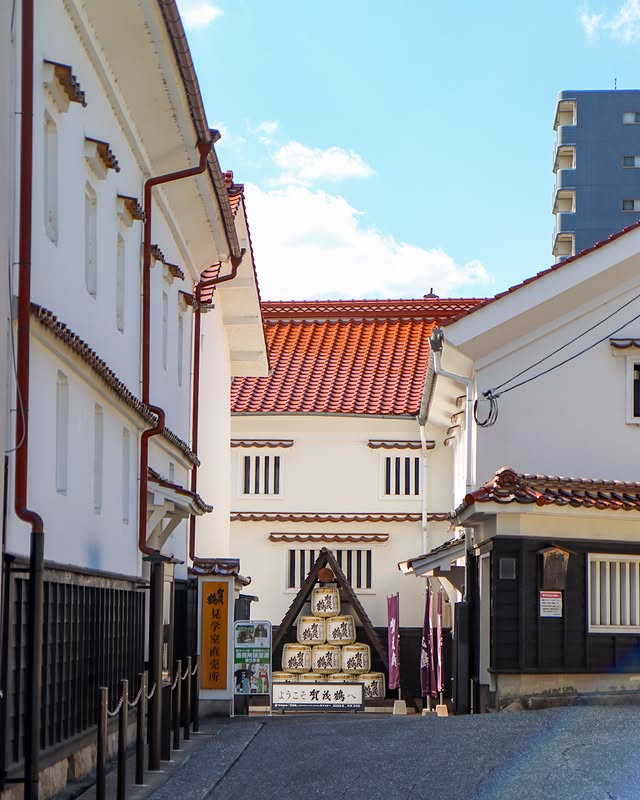
Saijō’s pure water and cool climate made it ideal for brewing sake. Over time, it became a sake capital, home to some of Japan’s most respected sake breweries. Walking through the town, you’ll notice white-walled storehouses and tall brick chimneys- symbols of its long brewing tradition.
Saijō symbolises Hiroshima’s craftsmanship and culture. Just like its history of resilience, the town’s sake-making reflects patience, skill, and the art of turning simple ingredients into something deeply meaningful.
You can join a brewery tour, taste different varieties of sake, and learn how it’s made. Each brewery has its own flavour and story to share. If you visit in October, the Saijō Sake Festival fills the streets with lively stalls, music, and thousands of sake samples to try.
Hiroshima Orizuru Tower
Hiroshima Orizuru Tower is a modern observation tower right beside the Atomic Bomb Dome. Unlike other viewpoints, it blends history, peace, and panoramic city views, giving visitors a space to reflect while enjoying a fresh perspective of Hiroshima.
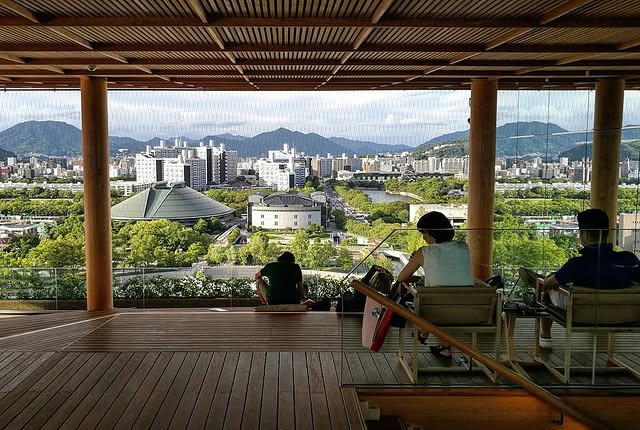
Opened in 2016, the tower was designed not just as an observation deck but as a place of hope. Its name comes from orizuru- the folded paper crane that became a worldwide symbol of peace through Sadako Sasaki’s story.
On the rooftop, you’ll find an open-air deck with sweeping views of the Atomic Bomb Dome, Peace Memorial Park, and even the mountains and sea in the distance.
Inside, you can fold your own paper crane and release it into the Orizuru Wall, joining thousands of others left by visitors from around the world.
Conclusion
Hiroshima shares a strong message of resilience along with rich cultural experiences. Key sites include the Peace Memorial Park and the Atomic Bomb Dome for reflection, as well as the peaceful Shukkei-en Garden and the impressive Hiroshima Castle for discovery.
If you have time, visit Miyajima Island, where the floating torii gate of Itsukushima Shrine offers a magical view. Be sure to try Hiroshima’s famous okonomiyaki and oysters.
Whether you are interested in history, nature, or local food, Hiroshima makes a lasting impression.
Ready to explore Hiroshima for yourself? Let us plan your journey today and discover the past, present, and peaceful beauty of this unforgettable city.
Frequently Asked Questions on the Best Places to Visit in Hiroshima
What is Hiroshima best known for?
Hiroshima is most famous for the Peace Memorial Park and the Atomic Bomb Dome, symbolising peace and resilience.
Which are the top places to visit in Hiroshima?
Highlights include Hiroshima Peace Memorial Park, Itsukushima Shrine on Miyajima Island, Hiroshima Castle, and Shukkeien Garden.
How far is Miyajima from Hiroshima city?
Miyajima is about 30 minutes by train and ferry, making it a popular half-day trip.
Can I explore Hiroshima in one day?
Yes, you can see the Peace Park, Museum, and Miyajima in a day, though two days allow a more relaxed visit.
What’s the best time to visit Hiroshima?
Spring (March-May) and autumn (October-November) are ideal for pleasant weather and beautiful scenery.